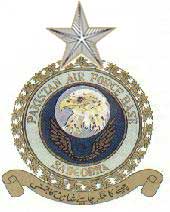|
The history of PAF Base, Sargodha can be traced back to July 51, when the disused WW II airfield was first occupied by a PAF Care and Maintenance Party. With this, the first step had been taken and by 16th November 1959, all the infrastructure had been completed under the supervision of Wing Commander R D Rollo to make Sargodha ready to receive its first flying squadrons.
Group Captain Salahuddin was posted in November 59 as the first commanding officer of PAF Station Sargodha. Over the next five months, by April 60, Nos. 5, 11 and 16 Squadrons equipped with F-86F aircraft, had been positioned at this base.They comprised No. 33 Wing.
As planned by Air Marshal Asghar Khan, Sargodha developed rapidly to become the most important base in the central region of the country and was geared to undertake the whole range of operational missions. In September 1961, No. 9 Squadron was also moved to Sargodha from Kohat and reequipped with the newly inducted F-104s, the PAF's first Mach 2 fighters. In the 1965 War, Sargodha proved to be the most important PAF base and played a decisive role in the defence of Pakistan with its spectacular performance under Group Captain Zafar Masud. Soon after that war, Chinese F-6s joined the PAF inventory and again Sargodha Base was the first to receive these aircraft. This event was closely followed by yet another induction, the French Mirage-III, which replaced 5 Squadron's Sabres.
Adhering to a well conceived layout, Sargodha Air Base has, continually improved with time in both its residential and operational facilities. Sensitive installations are well dispersed and a complex network of several taxiways and runways is routinely in operation at the same time. In' 1971, the clouds of war gathered over the subcontinent once again and culminated in another conflict between Pakistan and India in December. As in 1965, Sargodha base came through this fierce duel also with flying colours. After the war, Sargodha continued to set the pace of modernization across the entire spectrum of operational, maintenance and logistic disciplines in the Air Force. One of the most important events during this period was the formation of the Combat Commander's School in 1976, the successor to PAF's Fighter Leaders' School.
Another exciting chapter was added to the history of Sargodha base when, on 29th January 83, No. 11 Squadron became the first to receive the new F-16 Fighting Falcons. In March 1984, No. 9 Squadron was also reequipped with F-16s and moved to Sargodha. These two Fighting Falcon squadrons together constituted a flying wing which was designated as No. 38 Wing on 31st October 1984. In the wake of these developments, certain other changes also took place involving the move of No. 5 Squadron, 25 OCU and 33 Wing out of Sargodha. On 17th May 1986, a 38 Wing aircraft became the first PAF F-16 to score a kill when its pilot shot down an intruding Su-7 fighter of the Afghan Air Force. The air base continues to bristle with activity in several other fields including air defence, logistics and that of the nearby Headquarters of PAF's Central Air Command.
Compared with just 1 officer and approximately 25 airmen who manned Sargodha in its embryonic stage, the present strength of the base and its peacetime lodger units is more than impressive. Sargodha also provides administrative support to the pre-Academy PAF College which started as RPAF Public School in 1952 and now performs the role of an inter-services cadet training institution which it runs a two year university course for students belonging to the army, navy and air force.
Sprawling over several hundred acres of lush green soil, Sargodha air base has excellent technical and domestic accommodation, colleges and schools, a large and well equipped hospital, sports grounds, a golf course and free hunting facilities and a reward - for killing the exceptionally tough wild boars which inhabit the area surrounding the airfield.
Inspiring episodes of sacrifice, patriotism and sense of duty displayed by the men of this base during the 1965 and 1971 Wars with India have earned the respect and admiration of the entire PAF, the people of Sargodha, those of the nearby villages and indeed the whole country. Sargodha is justifiably proud of its nationwide fame as the City of the Shaheens and is, till now, one of only 3 cities of Pakistan to be awarded the Hilal-e-Istiqlal which flutters proudly over the municipal hall. Wartime pilots of this air base have been awarded 2 Hilal-e-Juraats and several Sitara-e-Juraats for intrepidity of the highest order.
Taxiing out to their different runways each morning for take off, today's young pilots of Sargodha can strongly feel the presence of there departed warrior comrades of long ago who operated from the very same airfield: Sarfraz Rafiqui, Alauddin Ahmed, Muniruddin, Yunus Hussain and others. Then, as if to remind them of their privileged lineage, their eyes catch the simply lettered words on boards along the taxiway: RETURN WITH HONOUR.
|

